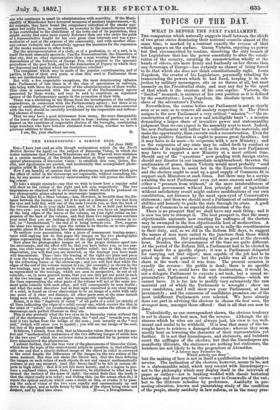THE STEREOSCOPE: A SIMPLE TEST.
let June 1852. Sra—I have just read an able though acrimonious article (in the North British Review for April) on the subject of Binocular Vision, in which the writer maintains that Professor Wheatstone and Dr. Whewell were mistaken at a certain meeting of the British Association in their conception of the optical phrenomena of binocular vision : to establish this case, Galen, Eu- clid, and Aguilomius are quoted, and incidentally that accomplished photo- graphic artist M. Claudet is attacked.
Now I am humbly of opinion that the phasnomena in question which give the effect of relief in the stereoscope are cognizable, without consulting Ga- len, by any person of an ordinary understanding who will pursue the follow- ing course. To take a simple example—say that we wish to know how a regular solid will show on the retinas of the right and left eyes respectively. The two impressions so obtained will be obviously those which would be produced on two photographic plates adapted to stereoscopic inspection.
Let the object be a 24mo volume,—less, therefore, in breadth than the dis- tance between the human eyes; let it be seen at a distance of two feet from the eyes and held flat, with one of the ends towards you, so that the back of the volume shall be to your right hand, and let it be so held just between the two eyes : you will find that on your left retina you have an impression of the long edges of the leaves of the volume, on your right retina an im- pression of the back of the volume, and that these two impressions convince your mind that you are looking at the real object, namely, a volume in re- lief, (or "foreshortened,") the end of it being towards you. Now, suppose the same two images as are upon the retinas to be thrown on to two photo- graphic plates fit for inserting into the stereoscope.
To analyze your perceptions, take a piece of transparent tracing-paper ; trace with copying ink on this paper the images on the two photographic plates representing those on the retinas of the right lind left eyes. Now place the photographic images set at the proper distance apart into the stereoscope, and the effect will be, that you have before you, as you sup- pose, one clear image of the volume in perfect relief; but in this, on 'closer observation, you will find you are deceived, as the tracings you have made will demonstrate. Thus—take the tracing of the right eye plate and place it over the tracing of the left eye plate, which is the same effect as that caused by the refracting lenses of the stereoscope ; and you will find that while the edges of the end of the volume nearest to you, (for example,) as shown in the two tracings, may be made precisely to coincide, the other edges of the book as represented in the tracings, which are seen in perspective, do not at all coincide,—or, in more general terms, that you can only get one point in each of the two tracings at one and the same moment to coincide precisely, and the lines representing the other parts of the volume will not at the same mo- ment quite coincide with each other, and will consequently be seen double ; and what the mind therefore had at first sight conceived as one clear image of a solid, .is found on closer observation to be an image of a solid with only one point of it clear and distinct, all other parts seen at the same instant being seen double, and to some degree consequently confusedly. Hence, it is this " duplicity of vision " of all parts of a solid (or strictly of all lines indicating the edges of a solid) except one, which creates the idea in the mind of "relief," (or foreshortening,) and which makes the effects of the stereoscope such perfect illusions as they are.
This is also precisely what the two eyes do in binocular vision without the aid of the stereoscope. Take a pencil-case, the " seal end " towards you, and hold it two inches from the bridge of the nose ; look intently at the " seal end," (which will cause you to squint) ; you will see one image of the seal, but two of the pencil-case itself. It follows, I submit, from this, that in binocular vision there is not the per- fect and " mathematical coalescence of the two differing images of solids seen by the two eyes" which the reviewer states is contended for by persons who have misconceived the phrenomena. submit further, that the true view of the phamomena of binocular vision, which form the topic of the controversial article in question, is that although only one and that a clearly-defined image of the object in relief is conveyed to the mind despite the differences of the images on the two retinas at the same moment, this does not shake the literal fact, that the lines defining the images on each retina of such objects do not and cannot mathematically coalesce at any one moment, (and this forces itself to be felt in certain ob- jects in high relief) : that it is not felt more keenly, and to a degree to pro- duce a confused vision, must, then, I conceive, be attributed to what may be termed the instinct of the sense of sight : the mind feels that the truth is that the object really is in relief ; and feeling this, (as the senses often do,) it repels the optical analysis which casts a doubt on this, or evades it by pass- ing the axis of vision of the two eyes rapidly and unconsciously up and down the object, and so holds firmly by the idea of the object being clear and


























 Previous page
Previous page